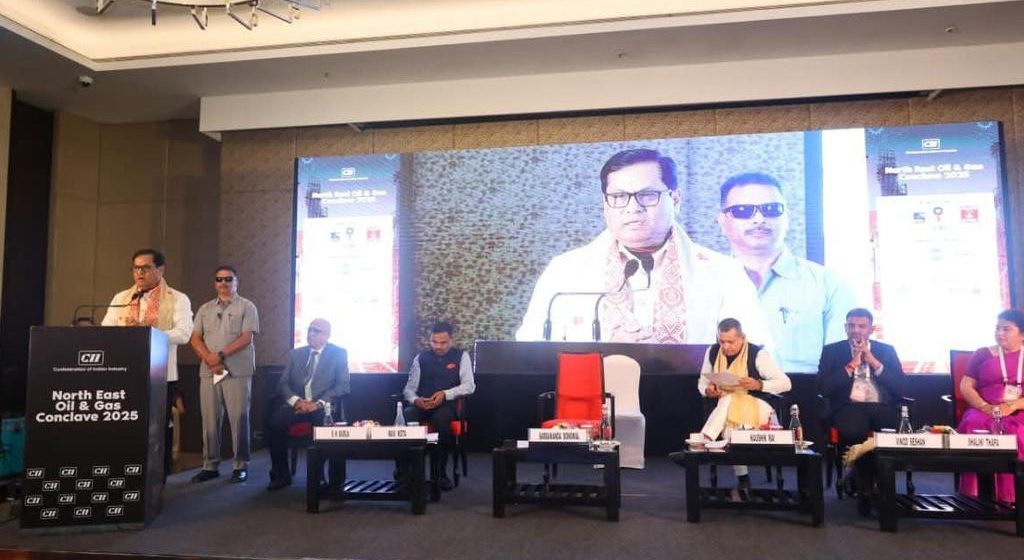Speaking at an energy conclave in Guwahati on Thursday, Sonowal said the rapid modernisation of India’s inland waterways is unlocking major economic opportunities while strengthening petroleum supply chains and export routes from Assam to Bangladesh and Southeast Asia.
Union Minister for Ports, Shipping, and Waterways Sarbananda Sonowal has stated that inland waterways, particularly those in the Northeast, are crucial to India’s objective of establishing a future-ready logistics ecosystem.
“Our efforts are aimed at reducing logistics costs, boosting trade, and creating new employment and industrial opportunities. The Northeast is ready to lead India into a new era of connectivity, sustainability and prosperity.”
Speaking at the North East Oil & Gas Conclave 2025, organised by the industry body the Confederation of Indian Industry (CII) in Guwahati on Thursday, Sonowal informed that the rapid modernisation of India’s inland waterways is unlocking major economic opportunities and strengthening petroleum supply chains and export routes connecting Assam to Bangladesh and Southeast Asia.
“The renewed focus on inland water transport has enabled smooth and swift cargo movement, reduced logistics costs and provided a reliable multimodal network for petroleum and industrial cargo across the Brahmaputra and Barak River systems. This has revived one of the oldest conduits of prosperity and repurposed economic activity in the hinterland.”
He added that jetties and terminals in Assam, including Pandu, Jogighopa, Dhubri, Bogibeel, Karimganj and Badarpur, have emerged as critical hubs for cross-border trade. These river terminals facilitate the export of petroleum products and large industrial consignments to Bangladesh and onward destinations, cutting transit distance, travel time and fuel consumption compared to road transport.
Sonowal highlighted the transport of over-dimensional cargo (ODC) for the expansion of Oil India Ltd’s Numaligarh refinery, and the ongoing movement of petroleum products via river routes, as proof of the operational efficiency and scalability of inland waterways. Year-round navigation, enabled through dredging and fairway maintenance, supports uninterrupted movement of heavy cargo for refinery, exploration and downstream industries.
“The inland waterways sector today stands as the backbone of energy transportation for the Northeast, reinforcing India’s energy security and unlocking new trade corridors,” he said, noting that annual cargo movement on NW-2 is now approaching 600,000 tonnes, driven by faster turnaround and reliable navigation.
Scalable Cargo Network
Sonowal said the government has undertaken ₹10 billion worth of inland waterway projects in the Northeast over the past two years, including permanent cargo terminals, ship repair facilities, tourist jetties and urban water transport systems. A ₹2.39 billion ship repair facility at Pandu is under development, expected to significantly reduce maintenance costs for river vessels that currently travel to Kolkata through Bangladesh for repairs.
Investments are also being directed toward river-based tourism infrastructure, lighthouse development, and skill and training facilities. A Regional Centre of Excellence in Dibrugarh, being built at a cost of ₹1.88 billion, will train nearly 5,000 students in maritime skills and logistics operations.
Sonowal further said that 76 national waterways will become operational by 2027.
“Cargo movement on national waterways reached an all-time high of 146 million tonnes last year, compared to just 18 million tonnes earlier. During India Maritime Week 2025, the Inland Waterways Authority of India signed MoUs worth ₹40 billion to enhance the efficiency of waterborne logistics.”
He added that the unprecedented increases—767 per cent in operational waterways, 635 per cent in cargo volume, 233 per cent in investment and 62 per cent in multimodal terminals—reflect the remarkable progress in the inland waterways sector.


